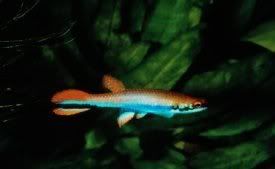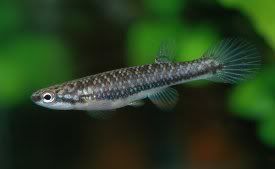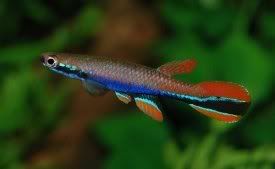Here is my original article.
Well I have written many an article for various clubs and forums but none with so much affection for a species of killifish than this little beauty. Maybe the fact that it took me over 10 years to aquire my initial stock that Rivulus xiphidius stands up there as my most favourite killifish species of all time. Now it may not be the most stunning of specimens along side some of the African species but when the morning light shines on a fully grown male it's surely a sight to behold. Theres just something about this species that just gives me a buzz each time I look into my tanks. You may never see or own this species but I would like to put something down on e-paper regarding my experiences with this South American jewel.
Rivulus xiphidius (Crique Boulanger)



General
My first encounter with this small rivulin from French Guyana was way back in the mid eighties at a BKA Convention held on the Leeds University campus. I was a member of the Collingham Group (small group of avid enthusiasts affiliated to the BKA) It was my duty to bag the peat from the show tanks of any annual / semi annual / peat spawner and peat divers tanks and to clearly label them with the species name, location and any valid collection codes. We had a guest speaker on the Sunday by the name of Fredrich Bitter from Germany who is now a world renouned fish importer. He had brought over a couple of F1 pairs which were entered into the show and then subsequently onto the following auction. I was awestruck by their beauty, even back then.
Needless to say they caused a bit of a stir in the auction room, and they went for a pretty penny. It wasn't until the winter of 95 that I inadvertantly stumbled upon this species again, I'd moved back home to Northern Ireland following the death of my mother., and was looking around for prospective killifish stock. I was invited to a fellow members house near the coast and he brought me into his fish-house. It was no pristine palace but boy he could breed fish. Wall to wall killifish tanks, I was like the proverbial kid in a sweet shop. Then I spied Xiphidius, tanks of the bloomin things of varying sizes from fry to adults. So you can imagine my extreme gratatude when he gave me 4 pairs for free on the proviso that I returned to him some offspring. I now had my stock WOW!
Rivulus xiphidius is a relatively small killifish from Surinam in French Guyana which inhabits small slow moving watercourses which is very soft and acidic and has a certain amount of stagnation and rotting vegetation so I had to produce something similar in their tank if I hoped to have any chance of breeding them. The adults attain a size of 45mm for the male and the female is considerably smaller at 30mm. I set up a few tanks with collected filtered rainwater mixed with tapwater roughly to a 75/25 ratio. Which came out fairly soft dH4 and a pH around 5, the temperature was kept at the recommended 77'F. They will only accept livefoods so here lay another problem which I needed to overcome so provisions were made to culture paramecium/infusoria, vinegar eel, microworm, grindalworm, whiteworm and vestigal winged fruitfly, This along with newly hatched brineshrimp would form the mainstay of their daily diet. Their tank would be heavily subdued with dense planting and light only entered the tank from the front and to one side. Pretty dark in there. Xiphidius like all rivulin species like to jump, these are amongst the most accomplished carpet surfers out there so an extremly tight fitting lid/coverglass is essential.
Colouration
For me to try and discribe the amazing colouration of an adult male of this species would truely do it a gross injustice so to that end I must refer you to the pictures above which accompany this article.
Sex & Breeding
Breeding this little gem presents quite a few problems, firstly the water conditions have to be whithin the boundaries of its natural habitat in order for the eggs to be viable and hatch without going bad. Possibly the sperm from the male may not survive conditions outside these parameters to sucessfully fertilise the egg. A tank of 8"x12"x10" was afforded to each pair of fish. Water conditions were maintained in or close to dh4, pH5 and 77'F with no artificial lighting. In each tank I provided a chunk of bogwood with a clump of Java fern, Indian fern was also used alongside Java Moss and Salvinia natans as floating cover. Into this tank I also placed one rather large and long floating mop (Dark Green yarn). A small air driven sponge filter was afforded as always and this was set to a slow trickle. Snails were mistakenly added (on the plants) and I had some concern about this at the start, would they eat the eggs. As it turned out I'd no need to worry as the harsh water conditions ment that they didn't survive long at least that particular species didn't.
In this enviorenment they remained, it suited me and the fish really well. I had the added bonus of collecting some eggs from the mops and also they spawned on the plant material and some fry could be reared using the natural method. I performed a 20% waterchange on a weekly basis and I added to this a capfull of Tetra Blackwater Extract. Their water was very dark in colour like weak tea with the tannins from the wood and the extract additive. After around a couple of weeks settling in and feeding well, I decided I'd better check for eggs. I would only pull eggs from the mop. I had to be careful as the fish made themselves very scarce and were to a point very timid. The mop had to be shaken in the tank and I had to assertain that I'd seen both prospective parents in the vessel before I could fully remove the mop. I would then subsequently check for any sign of spawning behaviour. I found eggs all over the mop but prodomitly in the top quarter near the cork. For such a small fish (female) the eggs are suprisingly large. I would say that the fish are not very prolific spawners compared to their African counterparts and I would estimate that they only lay about 6 eggs a day on average. I was told that this was a very good average compared to other breeders. So something must have been to their liking. At least they were spawning and the eggs were viable.
Eggs & Fry Rearing
As I said before the eggs were relatively large compared to the size of the fish. I collected them on a daily basis, Viable eggs are quite hard to touch and can easily be harvested from the mop. As these fish were of a delicate nature I placed no more than 6 eggs in a floating margarine tub with a sprig of Salvinia with a water depth of around 30mm. Loads of tubs were floating around the fish-house tanks at that particular time. The eggs hatch in about 16 days at a temp of 77'F. Its my belief that the fry of this species are too small upon hatching to accept anything other than infusorians as their first food so I added some on a daily bases for the first couple of days. (See Culturing Infusoria in the pinned section) You must be carefull not to overfeed and remove and replenish fresh water diligently on a daily basis. After a couple of days the fry will or should be large enough to move on to microworm and newly hatched brineshrimp. I tried vinegar eel but I didn't feel that this was doing any good. So with the fry on to brineshrimp nauplii I thought I could relax, The first hatch I got I lost every one, why I dont know, I had them up on larger foods and was meticulus is cleaning etc. maybe it was a water borne pathogen that claimed them or maybe becaust they are very skittish that I might have shocked them as I moved their container, I simply dont know. Once you approach the fry they dive for cover, remaining motionless, and are really difficult to find. Anyway with each and every subsequent hatch things were getting better. The fry are labouriously slow growing for the first few months which is when the males start to show some signs of colouration and its not until they are around a 10-12 mths old that they are sexually mature. The fry that subsequently hatch in the parents tank were sometimes caught using various methods including a tablespoon method (which need some practice I can tell you) But a lot of the time these fry were left to their own devices, they would have found infusorians in abundance given the amount of plant matter that was afforded to those tanks and they subsequently made as good an adult fish if not better and more robust than the hand reared ones. Just a little note on male rivalry here, the males do not tolerate each other too well and I like to grade (according to size) and seperate them as the need arises. Keeping a lot of males together without female company seems to quell this trait somewhat.
Summary
I, personall found this species pretty easy to breed given the proper water conditions and husbandry, the initial first few days after hatching and the need/ability not to shock the fish seems to be the only major stumbling block to rearing a batch of these sucessfully, They take quite a while to mature but it is truely worth the effort involved. This is the only killifish species (when breeding) kept me in the fish-house way into the wee small hours of the morning. You only get out of things what you are prepared to put in, I always say.
This is a beauty if a fish and one that will always have a place in my tanks wherever I may roam.
Breeding Overview
Tank size: 8"x12"x10"
Decor: Adults - Dense plant laden tank with bogwood (Java Fern, Java Moss, Indian Fern and Salvinia natans) with large floating mop, Fry - Salvinia natans and Java moss
Water: Soft dh4 - pH 5.0
Temperature: 77 F
Waterchanges: Weekly (20%) for breeders and Daily (20%) for fry.
Filtration: Air driven sponge filters set to a trickle.
Feeding: Livefoods only, little and often especially fry, remember to syphon off uneaten food.
Lighting: no artificial lighting.
Note:-
These fish along with other Rivulus species are excellent jumpers, they sometimes move from watercourse to watercourse in their natural habitats and will cover land to do so, so a tight fitting aquarium lid or coverglass is not only essential, it's a must.
I hope you enjoyed reading yet another personal account from my killifish breeding notes, and maybe some day one of you will aquire this beautiful killifish and use these jottings to help you in your quest to breed this stunning little fish which Mother Nature has seen fit to adorn us with.
Regards
Rivulus xiphidius ptI
- Details
- Written by Puddlefish
- Parent Category: Articles
- Hits: 5036

